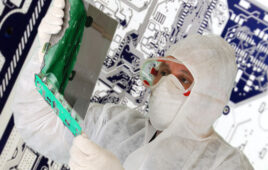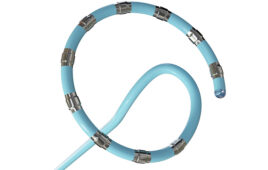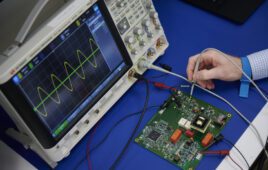 A position encoder is a device comprising a precision graduated scale and readhead (sensor). The encoder determines the position of the readhead on the scale and outputs this signal, in either analogue or digital formats, to a machine controller. Modern encoders may use optical, magnetic, capacitive or inductive principles to meet metrological requirements. Optical encoders are among the most accurate compact encoders on the market today, making them a preferred choice for most medical-robotic applications.
A position encoder is a device comprising a precision graduated scale and readhead (sensor). The encoder determines the position of the readhead on the scale and outputs this signal, in either analogue or digital formats, to a machine controller. Modern encoders may use optical, magnetic, capacitive or inductive principles to meet metrological requirements. Optical encoders are among the most accurate compact encoders on the market today, making them a preferred choice for most medical-robotic applications.
Robotic surgery and encoders
Medical robots are widely used to assist surgeons in surgical tasks requiring dexterity. General surgical procedures such as prostatectomy, hernia repair, hip and joint replacement, and others such as neurological surgery and laser-eye surgery are now commonly performed or aided by robots. Wristed robotic arms hold endoscopes and interchangeable surgical instruments in place while the surgeon manipulates them remotely either through teleoperation or computer control. These robots are capable of precise movements with dexterity far beyond even the most capable human surgeons. This can radically improve outcomes for patients.
A robotic manipulator arm comprises a series of rotational joints, each driven by a servomotor and precisely controlled using encoder feedback. In teleoperated robot surgery, the surgeon moves a master manipulator, also with servos and encoders, to command the slave manipulator or robot arm performing the surgery. This requires a complex control system to let the slave manipulators and their instruments precisely track the movements of the remote operating surgeon. Each motor-driven joint on the slave is controlled by a feedback loop that computes the motor command as a function of the difference between the current position and the target (set-point) position and as a function of the current velocity and target velocity. Rotary (angle) encoders on each joint may also provide some degree of force or torque feedback to the operating surgeon, via the master manipulator, as a function of the slave joint positions and velocity tracking errors so as to reflect the forces acting on the instruments.
To better detect and control fine movements in the joints, high-resolution rotary optical encoders are preferred for position and velocity sensing. These encoders feature low-mass components, miniature readheads, large through-diameters on the rotary scale, higher accuracy and precision, good immunity to scale contaminants, durability and safety of operation. Encoders on the joints of robotic manipulator arms require the highest accuracy and resolution to deliver the improvements in operative precision promised by robotic surgery – up to several orders of magnitude improvement in sensitivity.
The future of surgery
As encoders evolve, new procedures will become possible due to developments in robotics and attendant advances in the accuracy, precision, and non-invasiveness of surgery. Encoder feedback is vitally important for the safe and effective control and operation of robotic systems. Many of the world’s leading manufacturers of medical robots use optical encoders, such as Renishaw’s family of optical encoders, in their control systems.




